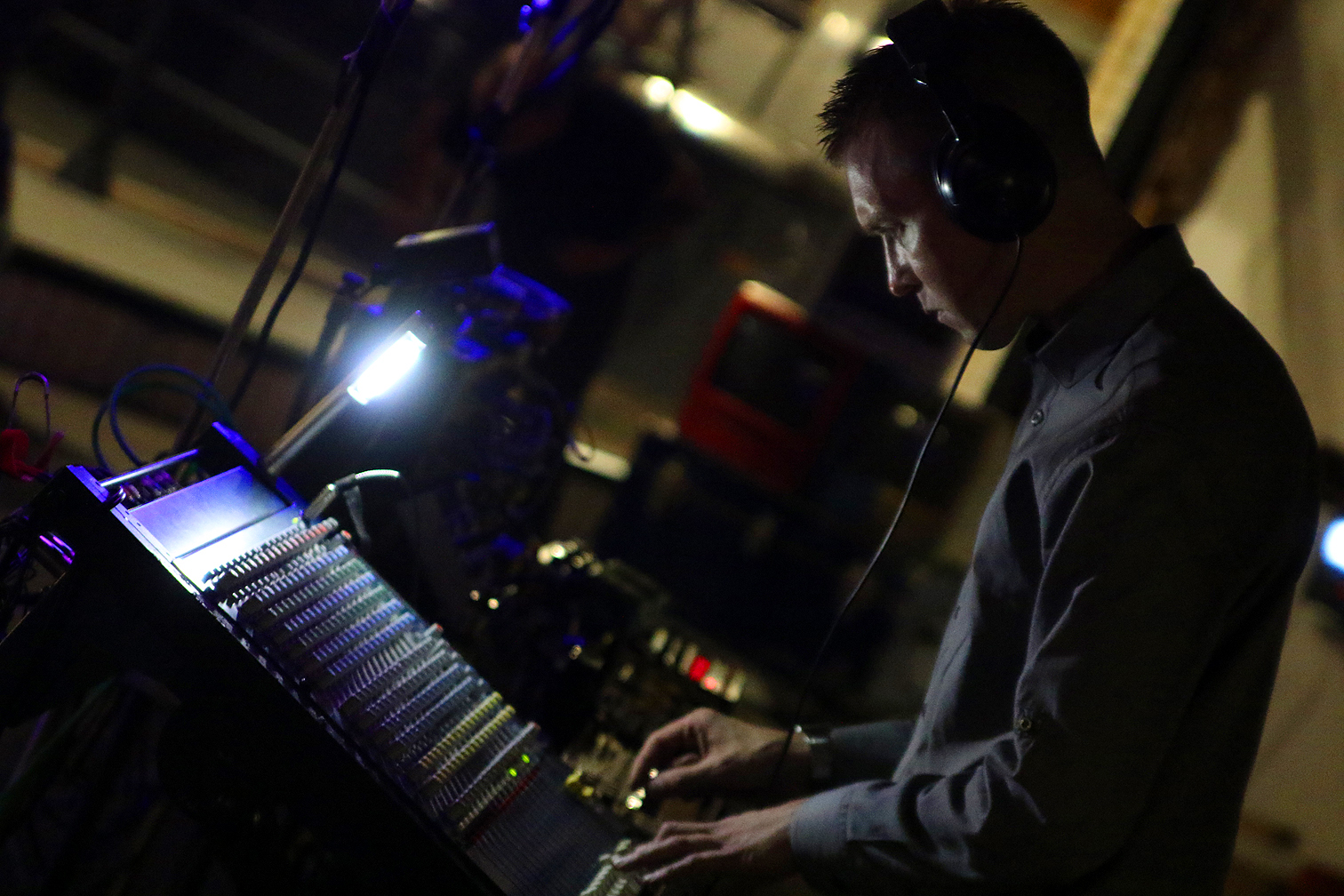
A footnote on the Facebook description of Santa Ana Noise Fest X reads “Remember Noise is a genre, not a volume.” On Saturday, 17 individuals and groups demonstrated a variety of sonic performances that do not fall neatly into any traditional musical category. That is not to say that traditional instruments were not played, but the manners in which they and non-traditional instruments were played and electronically manipulated placed the evening’s auditory environment strictly in the realm of the avant-garde.
As indicated by the X, this was the tenth annual Santa Ana Noise Fest, which has taken place exclusively at Orange County Center for Contemporary Art. Co-host Stephen Anderson, the former executive director of OCCCA, revealed at some point during the evening’s program that the event had started with an impromptu performance of some noise art.
The first group, Phog Masheeen, included Francene Kaplan wearing a long, platinum blonde wig and Mark Soden dressed in a lab coat with a hoodie and scarf or something similar to cover his mouth. The performance essentially consisted of Soden tapping drumsticks and manipulating the sounds, using various processing devices, to establish primitive rhythms and textures while Kaplan rang bells and dropped cooking pot lids onto the cement floor. The scene was complemented by heavily processed video footage — based off of a live video feed of the performers — being projected onto the performers and the wall behind them; Bill Almas handled the video work for all of the acts in this room. The only other illumination in the large exhibition room came from a couple LED strips of gradually changing colors.
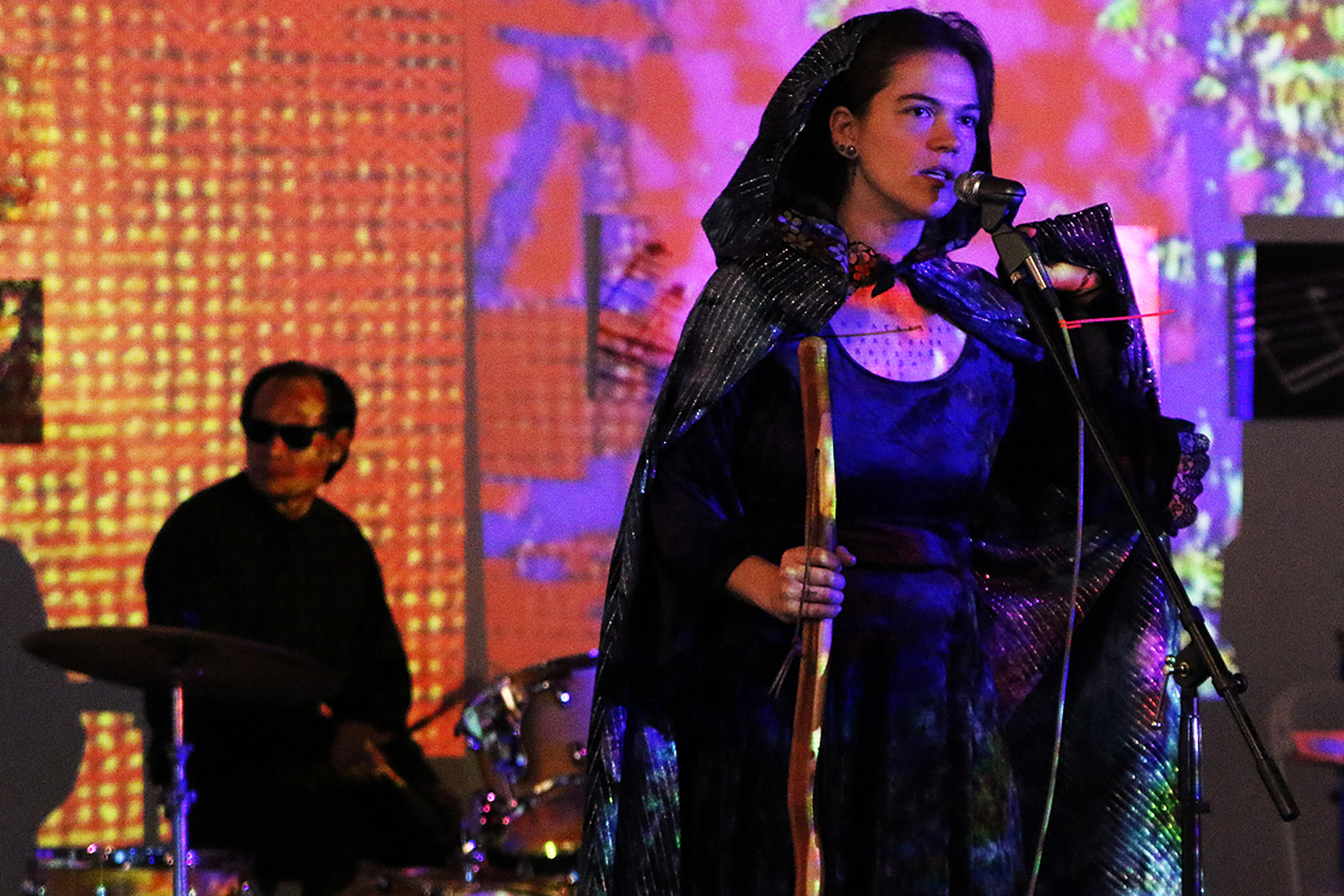
The net effect transcended the chaos of the environment and, if audience members were in the right frame of mind, they could sense that there was tranquility within the cacophonous environment. This is not to say that drugs were necessary to experience the transcendent sensation. There was, however, definitely one obvious candidate in this category; throughout the evening, one young woman stretched, contorted, pulled on her hair, and played with slinky ribbons and a scarf in a rather ecstatic manner while observing the various 20-minute performance sets.
Next up was a jazzy group called Squirrel Spam. This threesome consisted of a drummer, a keyboardist / guitar player / noisemaker, and a chanting witch, who introduced their set by saying, “I’ve done fake magic during my sets in the past. Tonight I’m going to perform real magic during my set.” Then, as the drummer tapped out a variety of beats and hits, and the other fellow played synthetic violin phrases, atonal piano and various sound effects, the young lady in sandals and a sparkling cloak lit incense, wandered the room to spread the smoke, performed a salutation to the compass directions, and then offered her contribution to the sound. Through spoken word and singing, she hypnotically chanted with the cadence of a yoga instructor riffing instruction in a variety of melodies and growls; all of her verse centered around encouraging audience members to visualize and move their energy around.
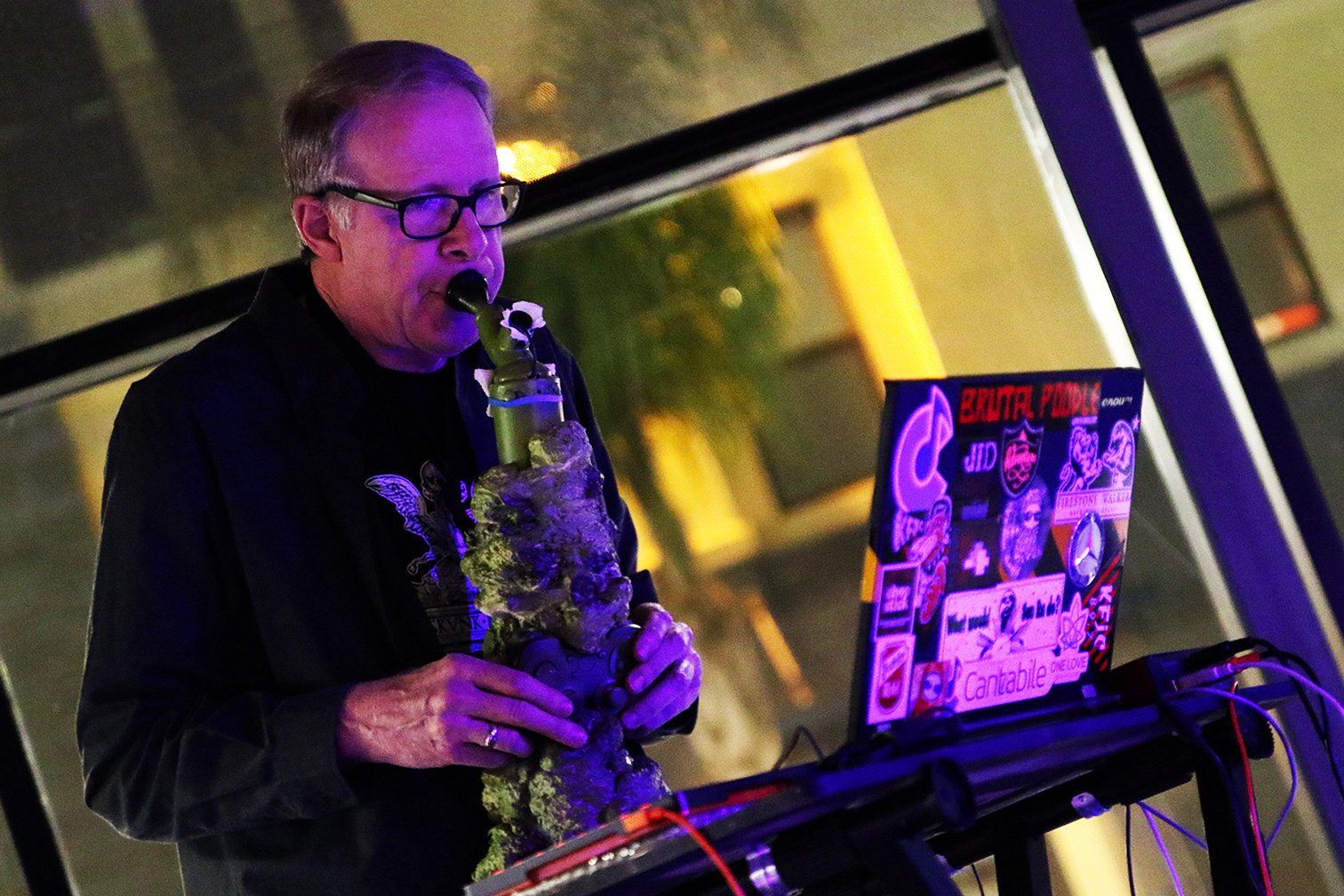
The next act, Skunk Puppet, took place in the front room of the art center, which was labeled the “Drone Room.” This act centered around a lone individual, who stood at a little stand with a computer, a noise generating pad / processor of some kind, and a very unique horn-like instrument. His set began with what sounded like a sample of an idling Harley-Davidson motorcycle engine, which he embellished with various synth flourishes. The space seemed a little cramped as guests who had been seated — in chairs or on the floor — in the other room were now huddled in a corner while Skunk Puppet performed opposite J3m5 (James Allen), who mixed the sound for the Drone Room throughout the evening; meanwhile performers for later sets proceeded to come and go, unloading their equipment. The highlight of Skunk Puppet’s set came as he operated his unique wind instrument, which resembled something of a hybrid between a bong and a mummified baby panda. The name of the instrument was the Sludge Horn.
After Skunk Puppet’s performance, the small crowd returned to the other room for a performance by Colin Russell. Russell performed on the floor, leaning over a large collection of effects processors. It started out sounding like amplified insect noises with lots of delay. Gradually, he introduced synth notes and created ambient tonal loops that he complemented with crackly sounds by smacking his connecting cables and rubbing a microphone on his facial stubble and flannel shirt. Finally, he added a layer of falsetto “wooo”s, which gave the entire sonic structure a fairly tranquil spacey / new agey feel. He concluded his set by returning to the insect-like crackling.
Cannibalistic Caterpillar followed up with Justin Scheid and Brian Akenoh on synths and processors. Their soundscape consisted of some very smooth sounds and nice textures, and the entire presentation sounded very deliberate — that is, no incidental connection pops, etc. in their maelstrom of synthplay — and included some synthetic beats that yielded very primitive and tribal rhythms.
Identity Combat was an anomaly. The act consisted of an individual screaming incoherently into a microphone with extreme levels of feedback for a very short duration, which culminated in his throwing of his equipment onto the floor and yanking out his patch cables. Throughout the evening, this was the most stark example of an artist using the elimination of his communicative means as part of his performance.
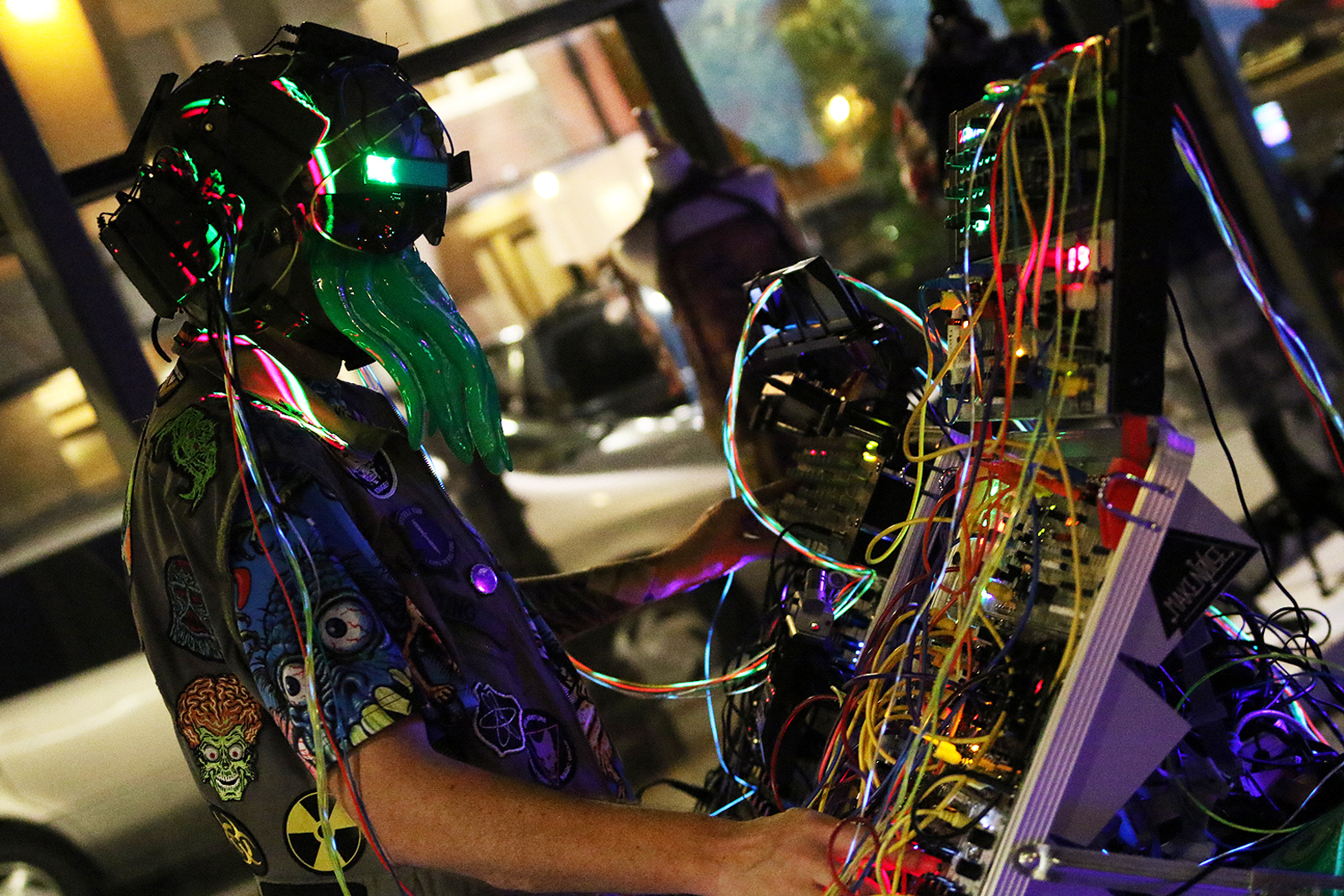
Back to the Drone Room for Pulsating Cyst, an artist with a massive setup of electronic toys of all sorts. This set was accompanied by a film made up of clips from various sci-fi flicks such as Brainstorm and Lawnmower Man. While his noise didn’t seem to have a particularly unique flavor — in the context of the other noisemakers — mid-set, the artist bent down, reached into a sack, and pulled a customized helmet with flashing LEDs and glowing neon tendrils. He then grabbed a couple of inflatable tentacles and ran out of the building, charging down the block like a renegade H.P. Lovecraft fanatic at a rave. When he returned to his setup, he amped up his sonic assault [no pun intended] to include a heavier dose of beats accompanied by animalistic electronic roars.
Next, Small Forest, aka Jeremy Stilgenbauer, delivered a rather chaotic assemblage of digital delay loops of ambient sounds and drones. The imagery this conjured was that of a prosaic video game character stumbling drunkenly through an endless field of electrified jello. It is likely that the nuance of some of his — and some of the other artists’ — work was hindered by the presence of dull amp buzzing, which still resonated loudly after Stilgenbauer was done manipulating sounds.
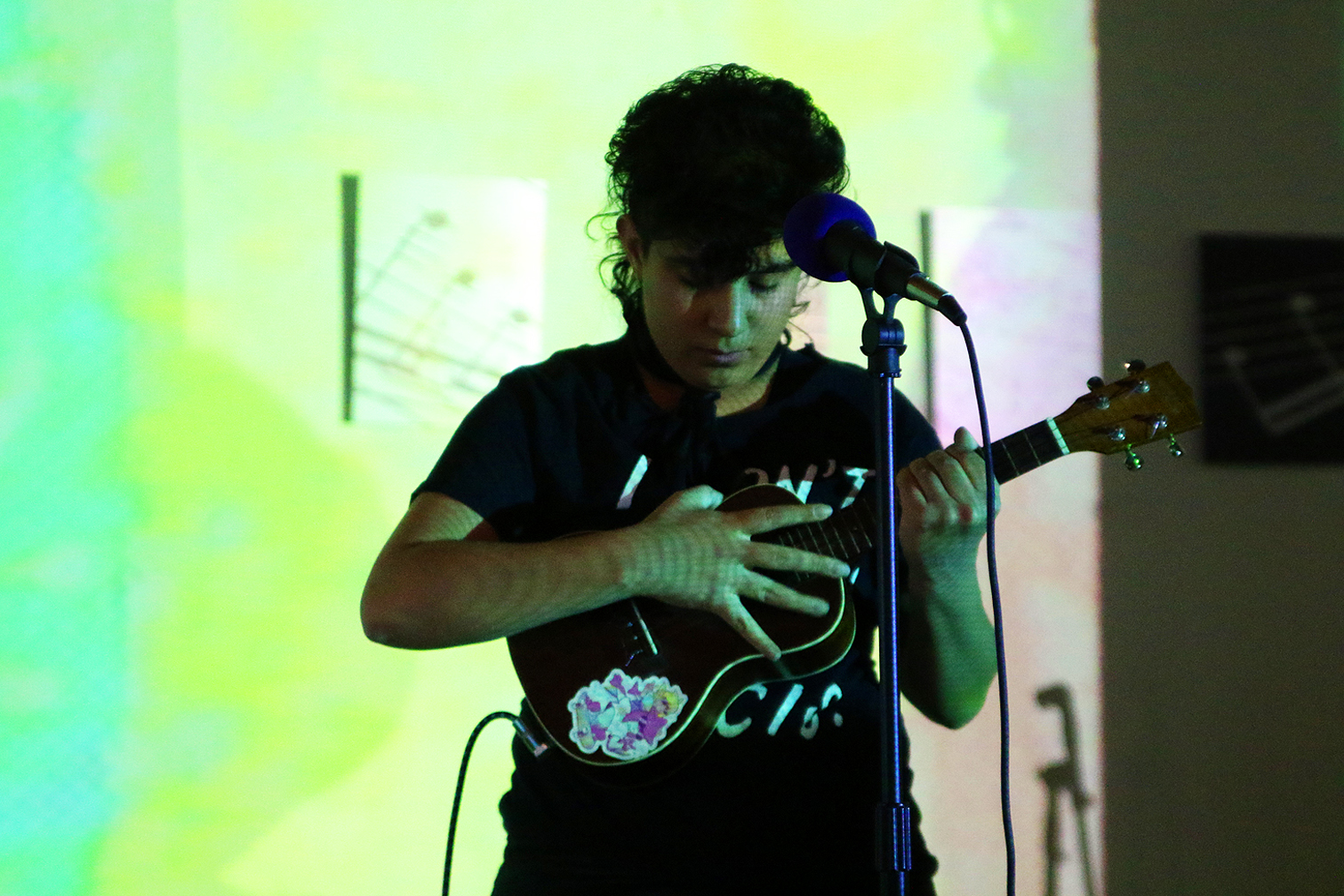
With TV MA, Therisse Van-Mar Amunatigui, the programming took a melodic change. Amunatigui’s set started off with a ukulele, which was sampled to create a loop on an Apple computer. Next, the artist sang along with the loop in a beautiful soprano voice. For the next tune, they used a unique instrument that looked like a gutted guitar body filled with electrical doodads to create another rhythmic loop, over which the artist played the flute, sampled that, looped it, and repeated the process several times. By the end, the melody had created imagery evocative of a luminescent forest populated by angelic pixies.
The Cloaca Sisters’ act was dominated by the imagery of the two artists hunched over their control panels, while dressed in grotesque costumes. Then, while one of the artists stood at the controls, the other alternately removed portions of costuming, hugged and tore open a large plush penguin, and threw Disney brand diapers into the audience. Their sonic environment was sheer mayhem.
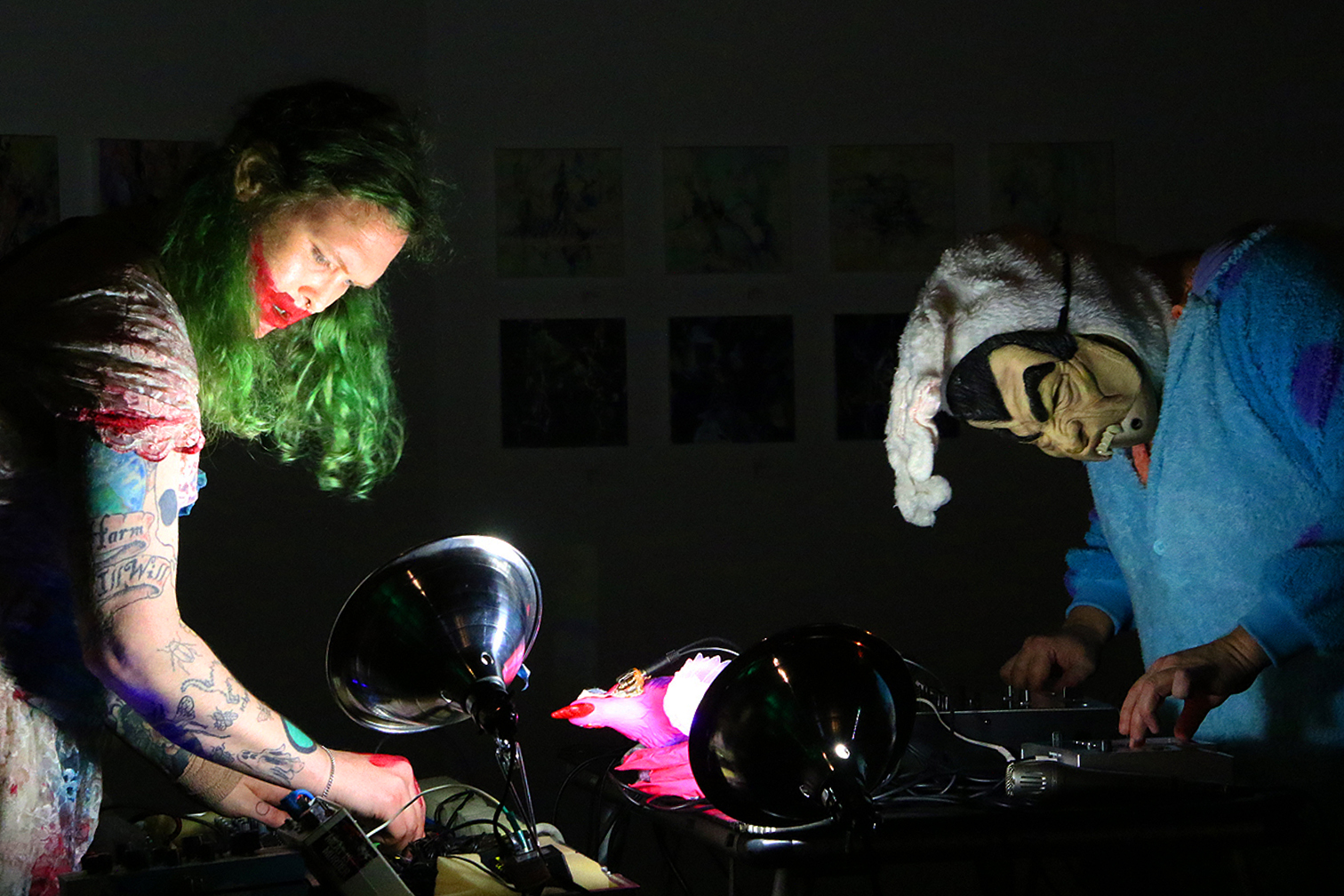
Only a little variety remained for this reviewer. For, as fascinating as all of the acts were, experiencing five hours of predominantly challenging sounds was a bit of a high order. Throughout the evening, the attendance stood at somewhere around 25 people — mostly the artists and OCCCA volunteers. A few stragglers, who had exited nearby bars and were probably en route to their cars, stopped in to take a photo with their phones and then left. I, myself, remained for four more of the seven remaining acts, but after the partially melodic BURNT DOT — which featured Sarah Belle Reid playing and manipulating various horns in various fashions and Ryan Gaston making electronic blurps and squeaks on his digital toys — the chaotic feedback of the next three acts was too much for me.
Admittedly, univac was fascinating to watch, as it included the manipulation of moving mechanical parts, which generated sounds, which where then looped and manipulated. Miser was two fellows hunched over their boards creating an epic auditory sludge fight, and Jesus is Dead was Stephen Anderson and Yenny Bernal dressed in interesting costumes and combining the sounds of digital delay manipulation with the sound of a Tibetan singing bowl.
Unfortunately, I didn’t get a taste of the sounds of J3m5, DSCORP8, or Diclonius, but I have a feeling that their noises were just as nuanced as those of the artists I had observed. By this time in the evening, however, my head was making its own noise, and I yearned for silence.



One Reply to “Strange Sounds Transport Attendees at Santa Ana Noise Fest X”